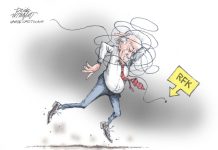On National Radio Day 2015, which is Thursday, the future of the world’s first electronic medium is — to borrow the language of a broadcast weather update — cloudy with a chance of sunshine.
If the day arrives without much hoopla, don’t be surprised: Radio faces tough, new competition from streaming services such as Pandora and Spotify. Smartphones have increasingly displaced clock radios, and Apple’s new audio service, Apple Music, launched this summer to great fanfare.
But radio’s believers say they’re adapting and have reason for hope.
Enormous reach, digital growth
Nielsen and Pew Research both report that more than 90 percent of Americans listen to traditional AM/FM broadcasting — a strong base to start from.According to Pew Research Center’s “State of the News Media 2015,” more than half of Americans 12 and older listened to online radio in the past month. The online audience has doubled since 2010.As more content is accessed via smartphones, radio executives continue to push mobile phone makers to activate FM radio chips already in their devices.
Sprint was the first to activate FM chips on some of its phones in 2013 in what some viewed as a test of consumer interest. Last July, broadcasters hailed a decision by AT&T to include FM chip activation in Android smartphones starting next year.
Indianapolis-based Emmis Communications, which owns radio stations throughout the country, has helped lead the push for smartphone-based FM radio through its support of the NextRadio app, and Emmis CEO Jeff Smulyan says the AT&T decision is the “tipping point” in persuading mobile carriers to turn on the radios in their phones.
Reliable in emergencies
The National Association of Broadcasters says that besides local news, weather and entertainment, FM offers “fail-safe emergency alert connectivity,” a frequent argument for including radio capability in phones.Broadcasters argue that radio is highly “survivable” in a crisis that could knock out Internet and other communication services.Craig Fugate, administrator of the Federal Emergency Management Agency, has supported FM radio availability in smartphones. As an example, he cited the effect on communications from an earthquake in Virginia.
“There was no real damage to the cell system,” he said in a video produced by freeradioonmyphone.org. “But there was such high data demand, the system crashed, and you couldn’t dial out. So all of a sudden your smartphone became a brick, and you didn’t have anything.”
On National Radio Day, as the industry adapts to changing tastes and technology, radio’s supporters say they’re embracing new opportunities — and hoping to tie their own strengths to the next generation of mobile devices.
John Strauss is a journalism instructor at Ball State University and former general manager of the school’s public broadcasting TV and radio stations. His background includes reporting and editing positions with The Associated Press and in local print, television and radio.




